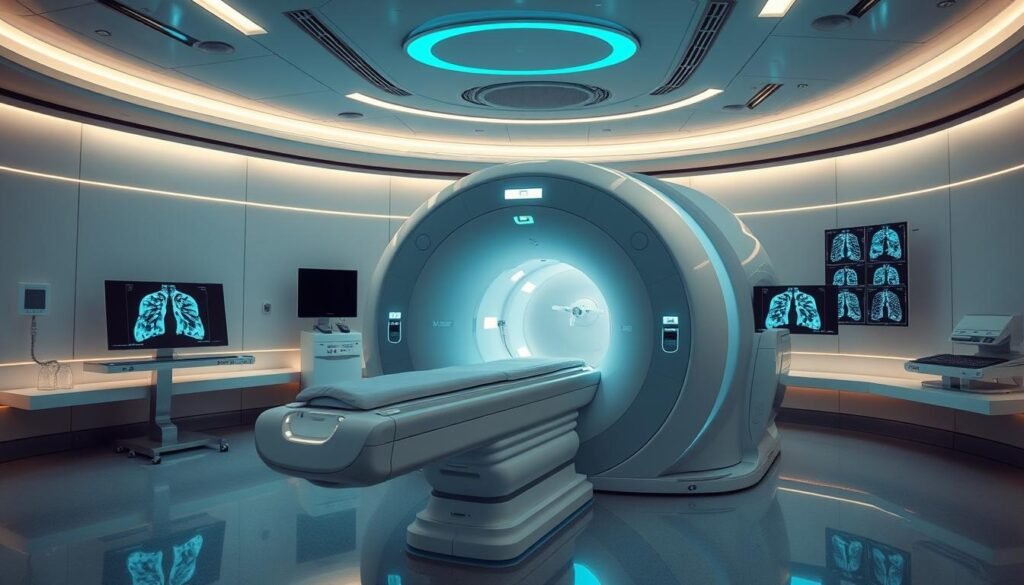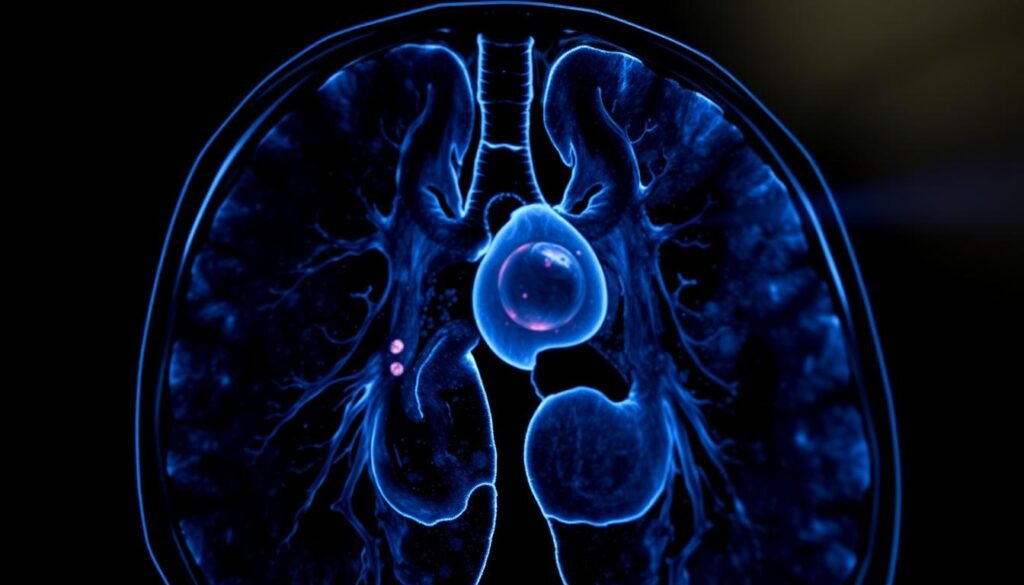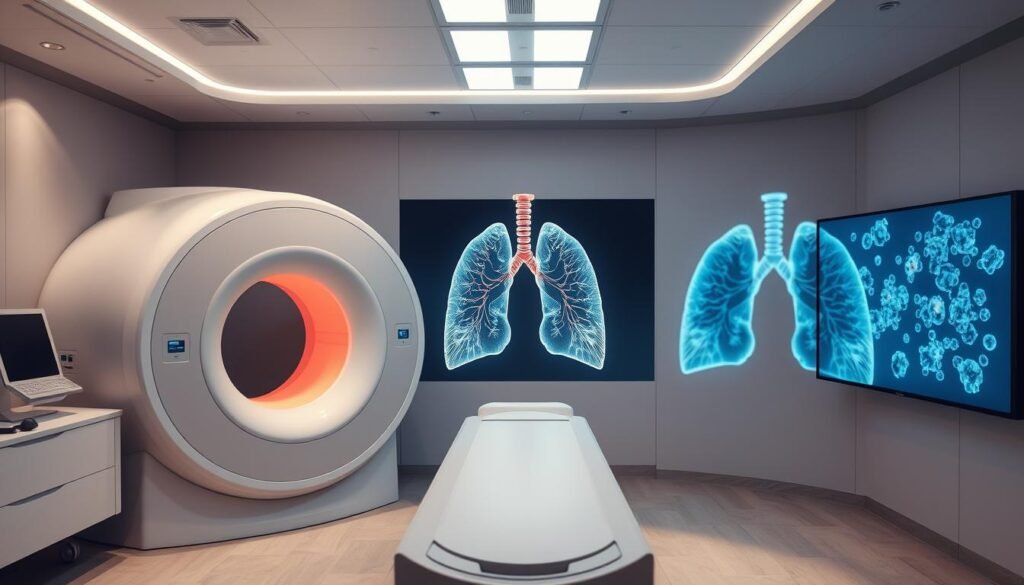In 2020, lung cancer took about 1.8 million lives across the world. It’s a leading cause of cancer deaths. This fact shows we need better ways to find lung cancer early. Catching it early helps save lives. That’s why early MRI screenings for lung cancer are so important. They are a new hope in the battle against this disease, a major health problem.
Studies keep showing us how MRI can spot lung cancer early and help patients. With MRI, doctors can see the cancer better and make a better plan to treat it. This can lead to earlier treatment, which can save lives. This article talks about how early MRI screenings can play a big part in finding lung cancer. It could make fighting this terrible disease a bit easier.
Key Takeaways
- Finding lung cancer early can greatly increase a patient’s chance of survival.
- Early MRI screenings can make diagnosing more accurate.
- MRI methods that don’t involve surgery are less hard on the patient.
- MRI is really good at showing what the tumor is like.
- Using MRI screenings could result in better health for patients.
Understanding Lung Cancer and Its Impact
Lung cancer is a big health problem, affecting many lives. It’s the second most common cancer in the U.S. and causes the most deaths. Knowing about lung cancer and how to fight it is vital.
Prevalence and Mortality Rates
In 2020, lung cancer took 1.8 million lives worldwide. It’s a fierce type of cancer. Small-cell lung cancer spreads fast. Most lung cancer, about 85%, hits people who smoke or used to smoke. This shows the strong link between smoking and this disease.
The chance of surviving lung cancer varies a lot by its stage when found. If found early, non-small cell lung cancer has a 65% survival rate. But for small cell lung cancer, it’s 30%. When found late, survival rates drop to 9% for non-small cell and 3% for small cell lung cancer. This shows why catching it early is key.
Importance of Early Detection
Finding lung cancer early is crucial. It helps a lot for people who smoked a lot. Early detection means better chances of beating the disease. It shows why screening is so important.
There are new ways to find lung cancer sooner, like low-dose CT scans. They work better than standard chest X-rays. These methods help find cancer early, which can save lives.
| Stage of Lung Cancer | NSCLC Survival Rate | SCLC Survival Rate |
|---|---|---|
| Early Stage | 65% | 30% |
| Late Stage | 9% | 3% |
What is MRI and How Does It Work?
Magnetic Resonance Imaging (MRI) is cutting-edge in medical diagnostics. It uses strong magnetic fields and radio waves for detailed body images. Non-invasive imaging like this is key in detecting various health issues, including lung cancer. MRI is safer than CT scans because it avoids radiation.
Non-invasive Imaging Technique
MRI is popular because it’s non-invasive. It means patients can get checked without surgery. It’s great for looking at soft tissues and organs. This makes it vital for spotting issues in the lungs. When used, the MRI machine produces clear images of lung tissue. This helps doctors find problems early on.
Advancements in MRI Technology
Technology has made MRI even better. Stronger magnets and new software, like artificial intelligence, mean clearer images. This leads to quicker results and more precise diagnoses. Studies show MRI can now find small nodules with 85% to 95% accuracy. These improvements make MRI a trusted tool in medicine.

The Role of MRI in Lung Cancer Detection
MRIs mark a big step forward in spotting lung cancer. They give us extra details that other scans, like low-dose CTs, can’t. This makes figuring out the exact location of lung tumors better. It helps doctors plan treatment that fits the patient’s needs.
Identifying Lung Tumors and Nodules
MRI scans are great at looking at soft tissues. This makes them really good for checking out lung nodules. They can show tumor edges and if the tumor has spread. This is key for understanding what kind of lung nodule someone has. Especially in tricky cases. Doctors use what they see on MRIs to decide what steps to take next. This makes finding lung cancer more accurate.
Assessing Tumor Staging and Progression
MRIs also help a lot with figuring out the tumor staging and how far the cancer has spread. They show lymph nodes and far-off cancer spread clearly. This is vital for picking the right treatment. How advanced the cancer is affects the treatment plan and how well the patient might do. Recent studies show that adding MRI to planning for radiation therapy can make treatments more tailored. For extra details on using MRI this way, check out this article.

| Imaging Technique | Key Strengths | Limitations |
|---|---|---|
| Low-Dose CT Scans | Ideal for detecting lung nodules and tumors; Quick imaging; High resolution | Radiation exposure; Limited soft tissue contrast |
| MRI | Superior soft tissue contrast; Excellent for assessing tumor invasion; No radiation exposure | Less effective for detecting lung nodules; Longer imaging time |
| Pet/CT Scans | Combines metabolic and anatomical information; Good for monitoring treatment response | Radiation exposure; Limited in early tumor detection |
Early MRI Lung Cancer: The Benefits of Early Screening
Early screening for lung cancer with MRI has huge benefits. It helps in finding cancer early. This increases the chances of a successful treatment and leads to better outcomes.
Improved Treatment Outcomes
Early detection gives patients more treatment choices. Time-sensitive discovery of the disease raises survival rates and improves life quality. MRI can spot small nodules precisely. This allows doctors to assess if a nodule could be cancerous.
With MRI, diagnosing 3-mm nodules correctly happens 90% of the time. For larger nodules, MRI has a 100% sensitivity rate. These success rates show how early screening can make treatments more effective.
Minimizing Invasive Procedures
Screening with MRI reduces the need for invasive tests like lung biopsies. Catching cancer early lowers the risks tied to such procedures. It also meets the patient’s wish for non-invasive methods.
With MRI tech, the need for surgery or chemo might drop. This can greatly improve life quality for those diagnosed. People at high risk, like smokers between 55 to 80, should get regular screenings. For more on early lung cancer signs, click here.

Comparing MRI and Low-Dose CT Scans
The debate on MRI vs. CT scans for detecting lung cancer is ongoing. It shows the pros and cons of both methods. Low-dose CT scans are highly praised for being able to spot tiny lung nodules. Finding these nodules early is key for successful treatment.
Gold Standard for Lung Cancer Screening
Low-dose CT is the top choice for checking for lung cancer, especially in people at high risk, like heavy smokers. Research from the National Lung Screening Trial shows these scans greatly reduce the risk of dying from lung cancer. They do this better than older chest X-rays. These scans are safer, too. They use much less radiation than regular CT scans but still give clear, detailed pictures.
Advantages of MRI in Specific Cases
In some cases, MRI scans offer benefits. They are really good at showing detailed images of soft tissues. This can help doctors understand complex tumors or check if cancer has spread to certain areas. So, MRI can be an excellent additional tool in these situations. Some new studies suggest MRI could better evaluate large nodules or tricky cancer cases. This helps doctors manage the patient’s care more effectively. A big study even found MRI useful for keeping an eye on unexpected lung nodules. You can learn more about how these imaging methods compare by reading this study.
Lung Cancer Screening Guidelines
Lung cancer screening guidelines are key in finding those at high risk early on. Catching the disease early improves odds of beating it. The US Preventive Services Task Force (USPSTF) has specific advice for doctors on who needs screening and how it’s done.
Who Should Be Screened?
If you’re between 50 and 80 and smoked a lot, you might need screening. This includes current smokers or those who have smoked heavily for many years. A “pack-year” means smoking 20 cigarettes a day for a year. It’s crucial to talk to your doctor about your health and if screening could help you.
- Current smokers or former smokers aged 50-80 with a 20 pack-year history
- Individuals who stopped smoking within the past 15 years
- Those with a history of lung cancer, COPD, or significant exposure to asbestos
Recommended Screening Methods
Low-dose computed tomography (LDCT) is the top choice for spotting lung cancer early. It can catch tumors when they’re smaller and easier to treat. Though LDCT is preferred, sometimes an MRI might be better for some patients.
Screening is usually done until the risk of screening is greater than its benefits. This might be due to age or health issues. Doctors and patients should decide together on screening, as there’s no one-size-fits-all answer.
The Limitations of MRI in Lung Cancer Diagnosis
MRI is key in finding cancer, but it’s not perfect, especially for lung cancer. It has some MRI limitations that impact its ability to spot the illness accurately. This can affect patient care and outcomes.
Understanding Sensitivity Issues
The effectiveness of MRI in finding lung nodules varies. Small nodules pose sensitivity issues, which affects how well MRIs can detect them. Nodules 5 mm or smaller have a low risk of being cancer, making them hard to detect.
For nodules between 3 to 5 mm, MRI’s sensitivity is around 86.3%. But, it’s 100% for nodules over 10 mm. Missing small cancers can delay early treatment.
Challenges with Motion Artifacts
Motion artifacts are a big problem in lung cancer MRI scans. Patients moving during the long scan time, about 60 minutes, can blur images. This makes it tough to get clear pictures for accurate diagnosis.
Compared to quicker methods like CT, the chance of patient movement with MRI is higher. This can mess up the result interpretation and miss important findings.
| Nodule Size (mm) | Prevalence of Malignancy (%) | MRI Sensitivity (%) |
|---|---|---|
| 4 or smaller | 0 | N/A |
| 5 – 9 | 6 – 28 | 86.3 |
| 10 – 19 | 64 – 82 | 95.7 |
| 20 or larger | 64 – 82 | 100 |
Future Directions in Lung Cancer Imaging
Today, lung cancer imaging is changing fast, thanks to new tech. Innovations like artificial intelligence (AI) in diagnostics and machine learning are key. They’re making image interpretation and diagnosis more precise.
These advances are set to change how we detect and handle lung cancer. It’s an exciting time for the field.
The Role of AI and Machine Learning
AI and machine learning will make lung cancer imaging better. They improve how we diagnose by spotting complex patterns that suggest cancer. Deep learning lets radiologists understand these patterns better.
With machine learning, we can handle heaps of data from lung cancer scans. This makes it easier to find important information.
Potential of Radiomics and Cancer Biomarkers
Radiomics lets us take numbers from medical images to help manage lung cancer. These numbers, combined with cancer biomarkers, can guide personalized treatment. This method makes treatment more accurate for each patient.
It leads to better predictions of disease outcome. This means we can catch cancer earlier and treat it more effectively. It’s a step forward from current imaging methods.
Conclusion
Early MRI lung cancer screening can change how we detect and screen for cancer. Although low-dose CT is currently the top choice for initial screenings due to its proven impact, MRI provides detailed assessments. This detail is key for patients with complex histories or those needing non-invasive approaches.
Early MRI is great at finding nodules 5 mm or bigger, doing so with 100% accuracy. This high sensitivity aids in diagnosing, making it easier to plan treatments and improve patient outcomes. Knowing about nodule sizes—especially the risk with ones over 8 mm—highlights the need for quick screenings and follow-ups.
As technology gets better, adding MRI to lung cancer screening plans could improve how we care for patients. By knowing the strengths and limits of each type of imaging, doctors can better catch lung cancer early. This strategy is key in battling lung cancer and raising survival rates for all patients.